Hi him ich hau mal wieder einen raus - ein Quickie, entstanden im Leerlauf, als ich für ein anderes Whif-Projekt (eine polnische Hawker Hurricane Mk. I, die
fast wirklich gegeben hätte) auf Aufkleber warten musste. Ein kleines und simples Kitbashing!

1:72 Kokusai Ki-202 Kai 'Goryō' (御霊); 4th Sentai, 3rd Hikotai; Ozaki AB (Yamaguchi Prefecture), Japan; April 1946 (Whif/Kitbashing/Luft '46) by
dizzyfugu, on Flickr
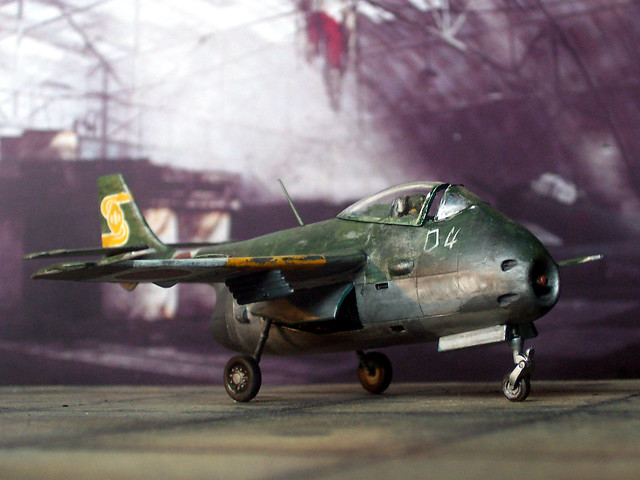
1:72 Kokusai Ki-202 Kai 'Goryō' (御霊); 4th Sentai, 3rd Hikotai; Ozaki AB (Yamaguchi Prefecture), Japan; April 1946 (Whif/Kitbashing/Luft '46) by
dizzyfugu, on Flickr
Some background:Both Imperial Japanese Army and Navy Aviation (IJA and IJN, respectively) were very aware of the developments of jet engines, esp. through close contact with Germany and mutual exchange of blueprints and even hardware. But it was the IJN which basically drove jet-powered aircraft, e. g. through the Kyūshū J7W2 Shinden or Nakajima J9Y1 Kikka fighters.
The IJA was far behind schedule. Its primary jet projects had been conversions of existing, piston-engine-driven bomber types, but the increasing threat through high and fast incoming B-29 bombers, as well as the potential danger of even faster, jet-powered types, stirred the development of fast and agile interceptors with a heavy armament.
 1:72 Kokusai Ki-202 Kai 'Goryō' (御霊); 4th Sentai, 3rd Hikotai; Ozaki AB (Yamaguchi Prefecture), Japan; April 1946 (Whif/Kitbashing/Luft '46) by dizzyfugu, on Flickr
1:72 Kokusai Ki-202 Kai 'Goryō' (御霊); 4th Sentai, 3rd Hikotai; Ozaki AB (Yamaguchi Prefecture), Japan; April 1946 (Whif/Kitbashing/Luft '46) by dizzyfugu, on Flickr
 1:72 Kokusai Ki-202 Kai 'Goryō' (御霊); 4th Sentai, 3rd Hikotai; Ozaki AB (Yamaguchi Prefecture), Japan; April 1946 (Whif/Kitbashing/Luft '46) by dizzyfugu, on Flickr
1:72 Kokusai Ki-202 Kai 'Goryō' (御霊); 4th Sentai, 3rd Hikotai; Ozaki AB (Yamaguchi Prefecture), Japan; April 1946 (Whif/Kitbashing/Luft '46) by dizzyfugu, on Flickr
Since no such indigenous design existed (the IJA rejected the logical option to adapt an IJN types!), German engineers and design had a strong impact on what was to become the Ki-202 - a parallel development to the two-engined, heavier Ki-201 "Karyu", which resembled much the German Me 262.
The Ki-202 was developed by the Nippon Kokusai Koku Kogyo in a very short time frame: initial work started in late 1944, and the prototype was ready in summer 1945. The Ki-202 was regarded as a light, dedicated interceptor for spot defence, which should be produced in large numbers and with less investment of sparse resources and work labor per unit than the Karyu.
The Ki-202 was a very compact and simple aircraft. Outwardly it bore a striking resemblance to Kurt Tank's Ta 183 "Huckebein" jet fighter that had been under development in Germany since 1942, but the Ki-202 was much more simplified, both concerning construction and aerodynamics, as it was so direly needed and, beyond the jet engine, no big development risk was to be dared.
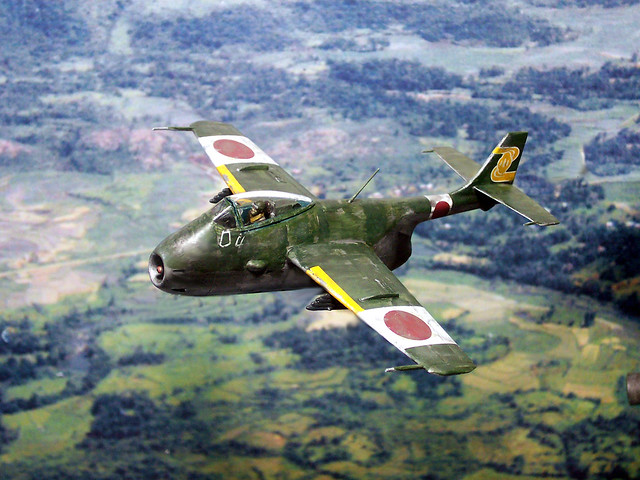 1:72 Kokusai Ki-202 Kai 'Goryō' (御霊); 4th Sentai, 3rd Hikotai; Ozaki AB (Yamaguchi Prefecture), Japan; April 1946 (Whif/Kitbashing/Luft '46) by dizzyfugu, on Flickr
1:72 Kokusai Ki-202 Kai 'Goryō' (御霊); 4th Sentai, 3rd Hikotai; Ozaki AB (Yamaguchi Prefecture), Japan; April 1946 (Whif/Kitbashing/Luft '46) by dizzyfugu, on Flickr
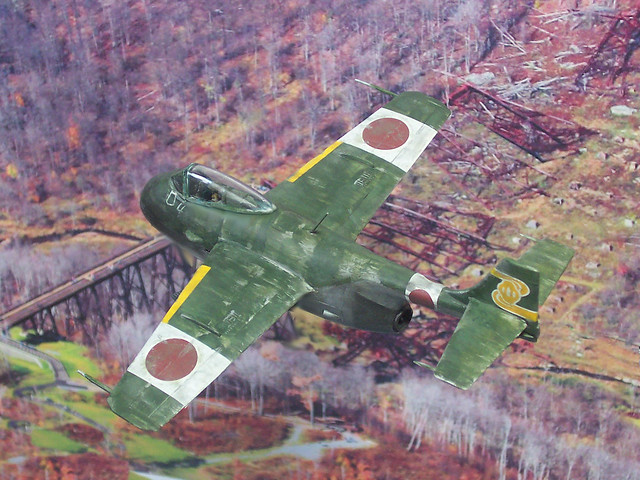 1:72 Kokusai Ki-202 Kai 'Goryō' (御霊); 4th Sentai, 3rd Hikotai; Ozaki AB (Yamaguchi Prefecture), Japan; April 1946 (Whif/Kitbashing/Luft '46) by dizzyfugu, on Flickr
1:72 Kokusai Ki-202 Kai 'Goryō' (御霊); 4th Sentai, 3rd Hikotai; Ozaki AB (Yamaguchi Prefecture), Japan; April 1946 (Whif/Kitbashing/Luft '46) by dizzyfugu, on Flickr
For instance, in order to avoid trouble with swept wings (which had not been incorporated in Japanese aircraft design yet, even though some wind tunnel test results already existed, as well as scientific input from Germany), the Ki-202 featured straight wings with a laminar-flow profile. The tail section was also different from the Ta 183: instead of the Ta 183's highly swept tail fin and a T-tail arrangement, the Ki-202 featured a relatively slender, staright tail boom above the jet exhaust, carrying a conventional stabilizer arrangement with only moderate sweep.
The fuselage resembled much Hans Multhopp's Ta 183, with a nose air intake, the pressurized cockpit placed above the air duct. The cockpot featured a frameless bubble canopy with an armored windscreen that offered an excellent field of view. Another novelty for the IJA was a tricycle landing gear that retracted into the lower fuselage. The engine (initially a single Ishikawajima Ne-20 turbojet, rated at 4.66 kN/475 kgf) filled the whole lower fuselage half. It lay between the main landing gear wells, with fuel cells above them and in the wing roots.
 1:72 Kokusai Ki-202 Kai 'Goryō' (御霊); 4th Sentai, 3rd Hikotai; Ozaki AB (Yamaguchi Prefecture), Japan; April 1946 (Whif/Kitbashing/Luft '46) by dizzyfugu, on Flickr
1:72 Kokusai Ki-202 Kai 'Goryō' (御霊); 4th Sentai, 3rd Hikotai; Ozaki AB (Yamaguchi Prefecture), Japan; April 1946 (Whif/Kitbashing/Luft '46) by dizzyfugu, on Flickr
 1:72 Kokusai Ki-202 Kai 'Goryō' (御霊); 4th Sentai, 3rd Hikotai; Ozaki AB (Yamaguchi Prefecture), Japan; April 1946 (Whif/Kitbashing/Luft '46) by dizzyfugu, on Flickr
1:72 Kokusai Ki-202 Kai 'Goryō' (御霊); 4th Sentai, 3rd Hikotai; Ozaki AB (Yamaguchi Prefecture), Japan; April 1946 (Whif/Kitbashing/Luft '46) by dizzyfugu, on Flickr
The aircraft had a rather stubby appearance, but turned out to be easy to handle and highly agile. Its weak spot was the Ne-20 engine, which was based on the German BMW 003 turbojet. Its low power output limited the Ki-202's performance so much that the initial prototypes (two were built) could only take off with reduced fuel - in fact, one of these machines was lost when it overrun the runway and crashed beyond repair.
Hence, only basic flight testing without any military equipment on board could be done until April 1945, and after the starting crash the other prototype was actually towed into the air, where it would, at safe height, power up its engine and perform a very limited test program.
When it became available in May 1945, a slightly uprated Ne-20-Kai engine was installed, but this measure hardly made the aircraft suitable to serious military service.
Things changed dramatically with the introduction of the much improved Ne-230 and Ne-330 engines. The latter had a thrust rating at 12.75 kN/1.300 kgf of thrust - nearly three times of what the early Ne-20 could deliver and close to the German 2nd generation Heinkel HeS 011 turbojet.
 1:72 Kokusai Ki-202 Kai 'Goryō' (御霊); 4th Sentai, 3rd Hikotai; Ozaki AB (Yamaguchi Prefecture), Japan; April 1946 (Whif/Kitbashing/Luft '46) by dizzyfugu, on Flickr
1:72 Kokusai Ki-202 Kai 'Goryō' (御霊); 4th Sentai, 3rd Hikotai; Ozaki AB (Yamaguchi Prefecture), Japan; April 1946 (Whif/Kitbashing/Luft '46) by dizzyfugu, on Flickr
 1:72 Kokusai Ki-202 Kai 'Goryō' (御霊); 4th Sentai, 3rd Hikotai; Ozaki AB (Yamaguchi Prefecture), Japan; April 1946 (Whif/Kitbashing/Luft '46) by dizzyfugu, on Flickr
1:72 Kokusai Ki-202 Kai 'Goryō' (御霊); 4th Sentai, 3rd Hikotai; Ozaki AB (Yamaguchi Prefecture), Japan; April 1946 (Whif/Kitbashing/Luft '46) by dizzyfugu, on Flickr
This new engine necessitated a slightly widened exhaust nozzle, and in the course of this modifications many detail refinements on prototypes #3 and 4 were made, including anti-flutter weights on the horizontal stabilizers and small wing fences.
In September 1945 this "new" aircraft eventually entered IJA service as "Ki-202 Kai", officially called 'Goryō' (御霊 - "Vengeful ghost") but also nicknamed 'Nezumi' (ネズミ - "Mouse") by its crews
The new type proved to be an immediate success. The Ki-202 Kai had a very good rate of climb, the short wings, coupled with a center-heavy CG due to the compact "pod and boom" layout, offered a very high manouverybility that was on par with contemporary Allied piston-engined fighters. As a bonus, its small size made the 'Goryō' a target which was hard to acquire or hit.
 1:72 Kokusai Ki-202 Kai 'Goryō' (御霊); 4th Sentai, 3rd Hikotai; Ozaki AB (Yamaguchi Prefecture), Japan; April 1946 (Whif/Kitbashing/Luft '46) by dizzyfugu, on Flickr
1:72 Kokusai Ki-202 Kai 'Goryō' (御霊); 4th Sentai, 3rd Hikotai; Ozaki AB (Yamaguchi Prefecture), Japan; April 1946 (Whif/Kitbashing/Luft '46) by dizzyfugu, on Flickr
 1:72 Kokusai Ki-202 Kai 'Goryō' (御霊); 4th Sentai, 3rd Hikotai; Ozaki AB (Yamaguchi Prefecture), Japan; April 1946 (Whif/Kitbashing/Luft '46) by dizzyfugu, on Flickr
1:72 Kokusai Ki-202 Kai 'Goryō' (御霊); 4th Sentai, 3rd Hikotai; Ozaki AB (Yamaguchi Prefecture), Japan; April 1946 (Whif/Kitbashing/Luft '46) by dizzyfugu, on Flickr
On the other side, the aircraft sported a powerful cannon armament (two fuselage-mounted 20 mm Ho-5 cannons, each with 150 RPG, plus two fuselage-mounted 30 mm Ho-155-II cannons, each with 50 RPG), and it was able to carry unguided air-to-air missiles under its wings, or two 150 L (40 US gal) drop tanks on either wing or a pair of 250 kg (550 lb) bombs.
On the downside, the Ne-330 engine had a very high fuel consumption rate, its throttle response was marginal, and its reliability was poor, especially in the initial production batches which suffered from material failures and lack of engineering experience.
General characteristics Crew: one
Length: 8.96 m (29 ft 4 in)
Wingspan: 9,74 m (31 ft 10 1/2 in)
Height: 3,69 m (12 ft 1 in)
Wing area: 17.5 m² (188 ft²)
Empty weight: 2,380 kg (5,247 lb)
Loaded weight: 4,300 kg (9,480 lb)
Powerplant: 1× Ishikawajima Ne-330 engine with 12.75 kN/1.300 kgf of thrust
Performance Maximum speed: 855 km/h (531 mph)
Stall speed: 140 km/h (92 knots, 106 mph) (power off, flaps down)
Range: 1.250 km (673 nmi, 776 mi)
Service ceiling: 14.000 m (45,932 ft)
Rate of climb: 20,4 m/s (4,020 ft/min)
Wing loading: 196 kg/m² (41 lb/ft²)
Thrust/weight: 0.37
Armament 2× 20 mm Ho-5 cannons with 150 RPG
2× 30 mm Ho-155-II cannons with 50 RPG
2× underwing hardpoints for up to 250 kg (551 lb) each
(for racks with unguided missiles, drop tanks or bombs)
Kenner erkennen vermutlich, woraus die Ki-202 gebastelt ist: die SEHR simple Ta-183 von PM Models sowie eine TS-11 'Iskra' von Master Craft (ex KP). Die Ta 183 fand ich schon immer sehr futuristisch - und die Frage war, wie so etwas ggf. in einer abgespeckten Variante ausgesehen hätte, ohne gepfeilte Flügelflächen? Also Säge angesetzt und etwas herumgespielt...

1:72 Kokusai Ki-202 Kai 'Goryō' (御霊); 4th Sentai, 3rd Hikotai; Ozaki AB (Yamaguchi Prefecture), Japan; April 1946 (Whif/Kitbashing/Luft '46) - WiP by
dizzyfugu, on Flickr
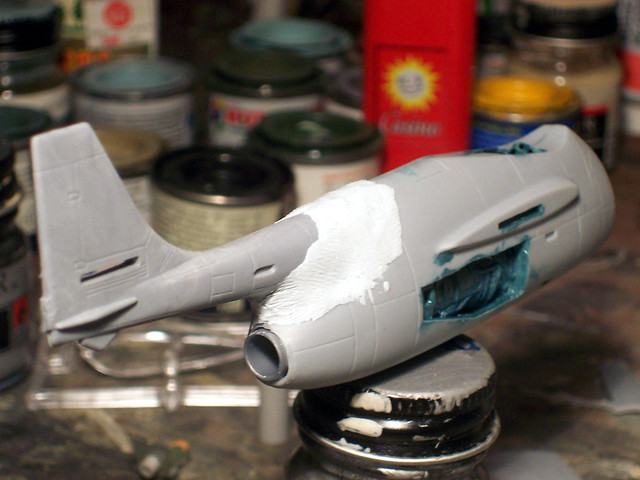
1:72 Kokusai Ki-202 Kai 'Goryō' (御霊); 4th Sentai, 3rd Hikotai; Ozaki AB (Yamaguchi Prefecture), Japan; April 1946 (Whif/Kitbashing/Luft '46) - WiP by
dizzyfugu, on Flickr
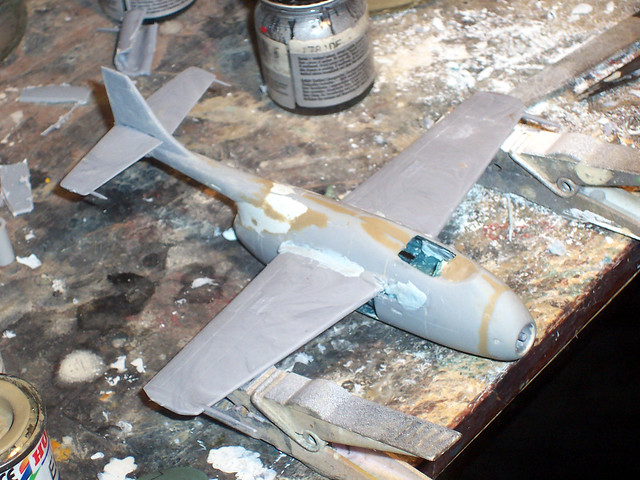
1:72 Kokusai Ki-202 Kai 'Goryō' (御霊); 4th Sentai, 3rd Hikotai; Ozaki AB (Yamaguchi Prefecture), Japan; April 1946 (Whif/Kitbashing/Luft '46) - WiP by
dizzyfugu, on Flickr
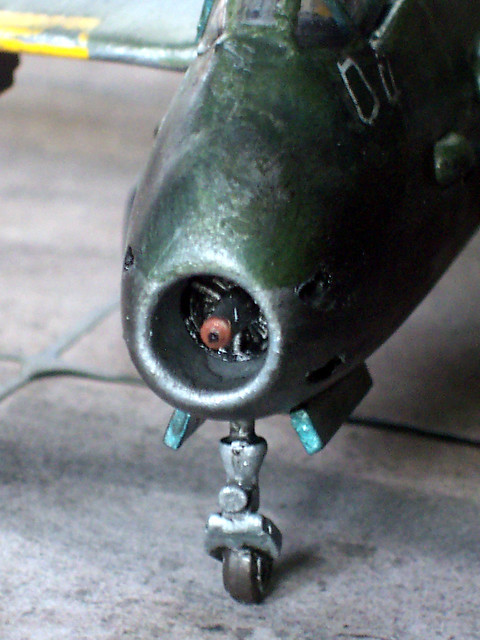
1:72 Kokusai Ki-202 Kai 'Goryō' (御霊); 4th Sentai, 3rd Hikotai; Ozaki AB (Yamaguchi Prefecture), Japan; April 1946 (Whif/Kitbashing/Luft '46) by
dizzyfugu, on Flickr
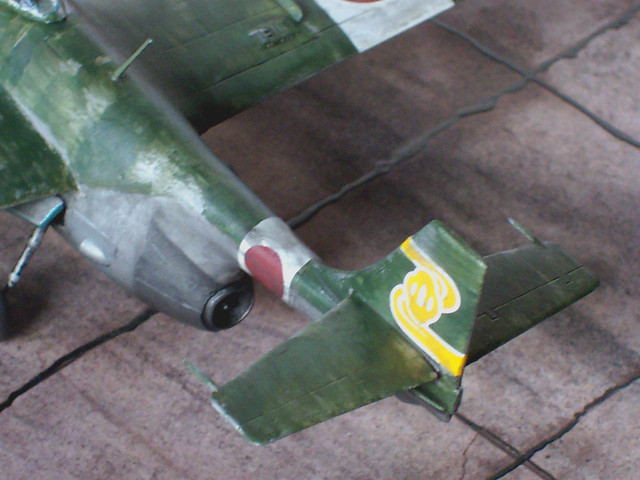
1:72 Kokusai Ki-202 Kai 'Goryō' (御霊); 4th Sentai, 3rd Hikotai; Ozaki AB (Yamaguchi Prefecture), Japan; April 1946 (Whif/Kitbashing/Luft '46) by
dizzyfugu, on Flickr
Letztlich ist im Detail noch einiges verändert worden, etwa am Fahrwerk. Die Schächte sind aufgesägt und ein Triebwerks-Dummy implantiert, das Cockpit ist etwas wohnlicher eingerichtet und ein Pilot zog noch ein.
Statt eine germanische Luft '46-Maschine draus zu machen fand ich es chicer, daraus ein japanisches Derivat zu machen - komplettes NMF, mit improvisierter, grüner Tarnung von oben und typischen Heimatverteidigungs-Markierungen. Innen alles mit Iodake Iro, sieht etwas kirre aus...
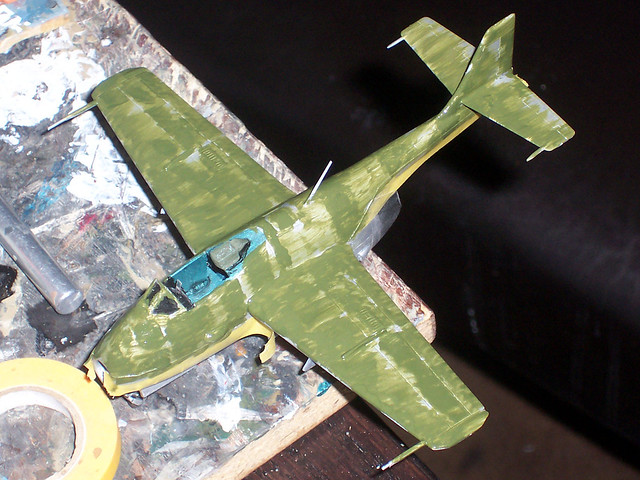
1:72 Kokusai Ki-202 Kai 'Goryō' (御霊); 4th Sentai, 3rd Hikotai; Ozaki AB (Yamaguchi Prefecture), Japan; April 1946 (Whif/Kitbashing/Luft '46) - WiP by
dizzyfugu, on Flickr
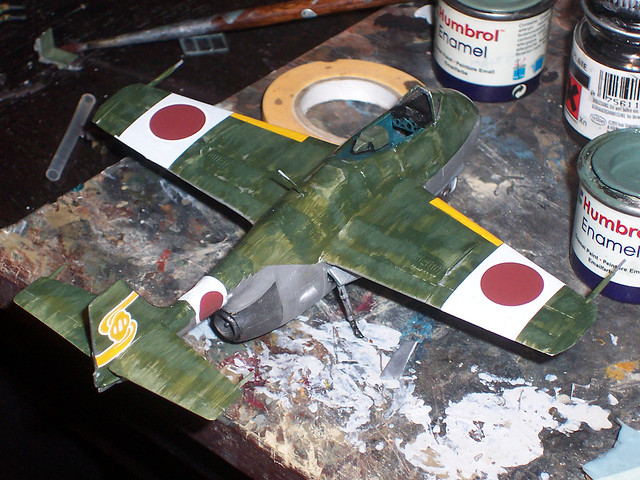
1:72 Kokusai Ki-202 Kai 'Goryō' (御霊); 4th Sentai, 3rd Hikotai; Ozaki AB (Yamaguchi Prefecture), Japan; April 1946 (Whif/Kitbashing/Luft '46) - WiP by
dizzyfugu, on Flickr
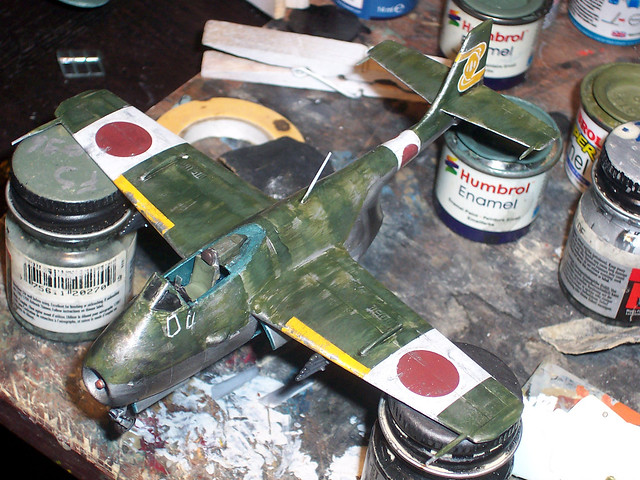
1:72 Kokusai Ki-202 Kai 'Goryō' (御霊); 4th Sentai, 3rd Hikotai; Ozaki AB (Yamaguchi Prefecture), Japan; April 1946 (Whif/Kitbashing/Luft '46) - WiP by
dizzyfugu, on Flickr
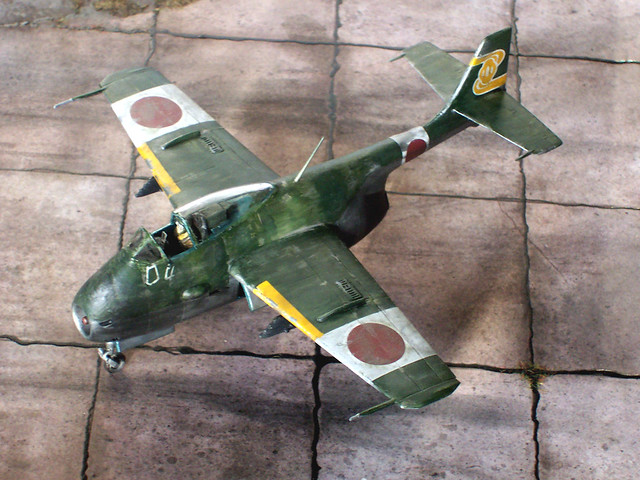
1:72 Kokusai Ki-202 Kai 'Goryō' (御霊); 4th Sentai, 3rd Hikotai; Ozaki AB (Yamaguchi Prefecture), Japan; April 1946 (Whif/Kitbashing/Luft '46) by
dizzyfugu, on Flickr

1:72 Kokusai Ki-202 Kai 'Goryō' (御霊); 4th Sentai, 3rd Hikotai; Ozaki AB (Yamaguchi Prefecture), Japan; April 1946 (Whif/Kitbashing/Luft '46) by
dizzyfugu, on Flickr